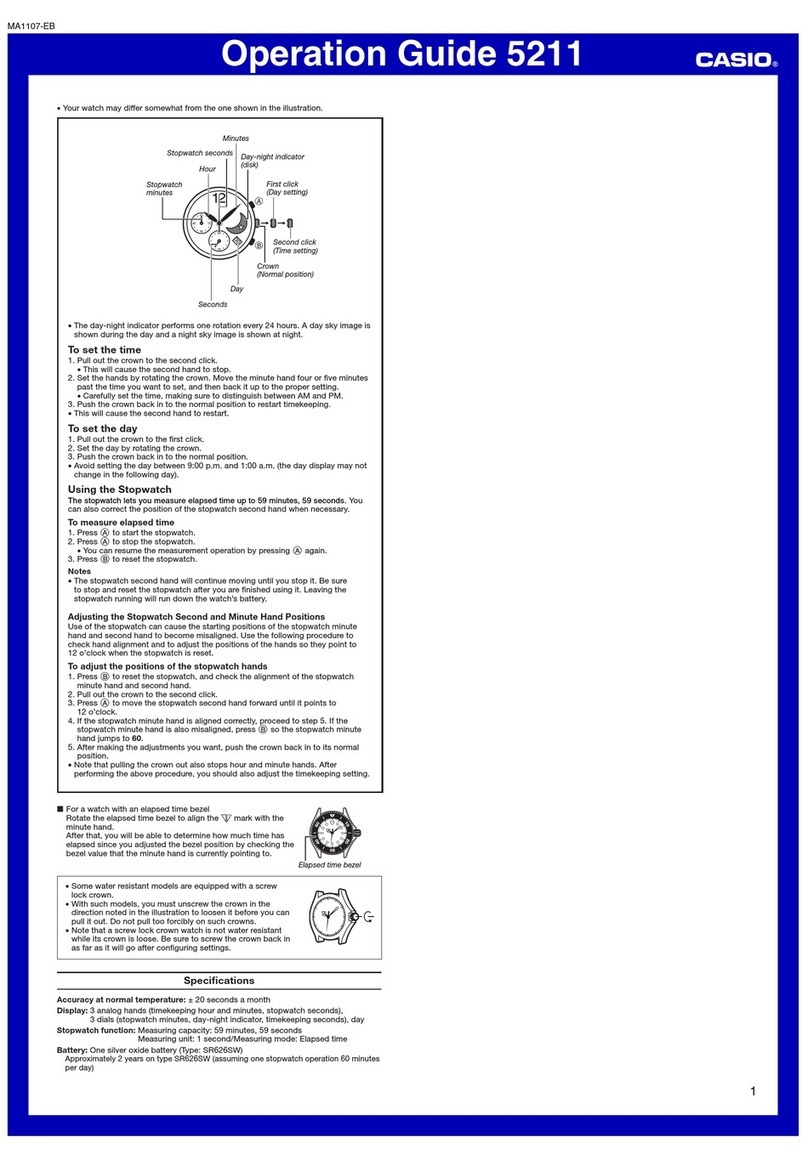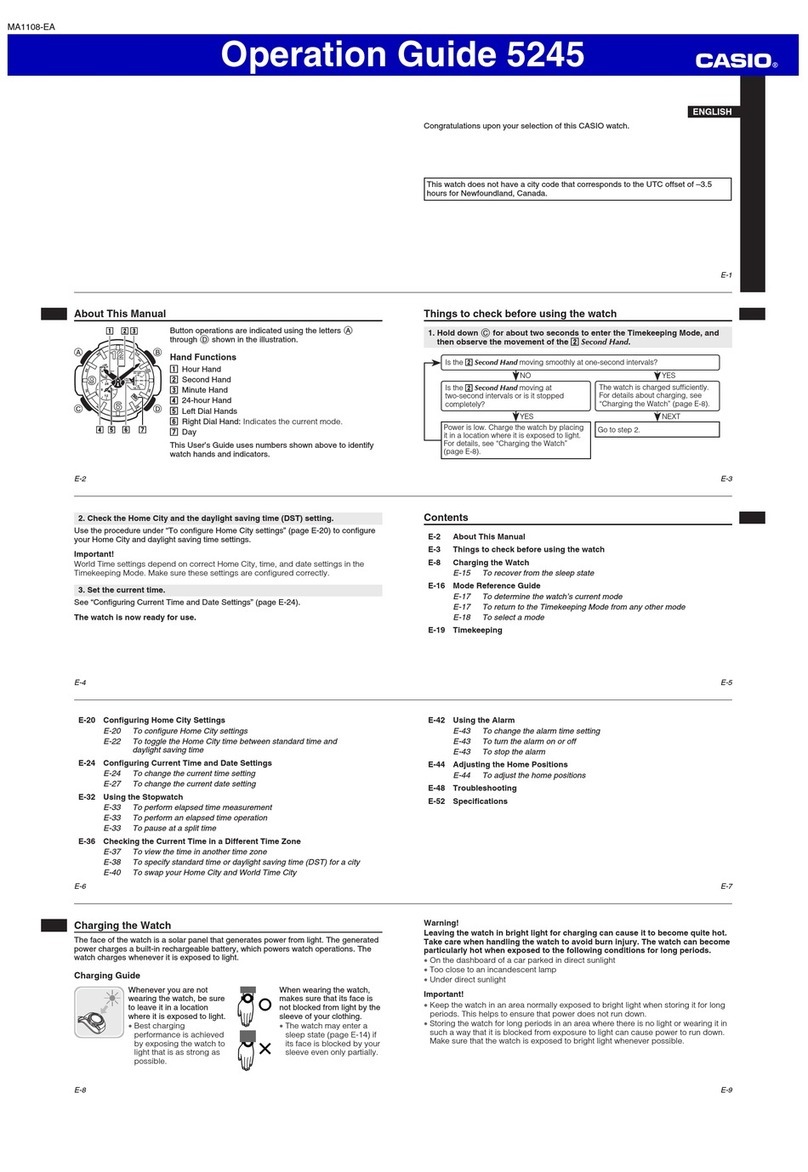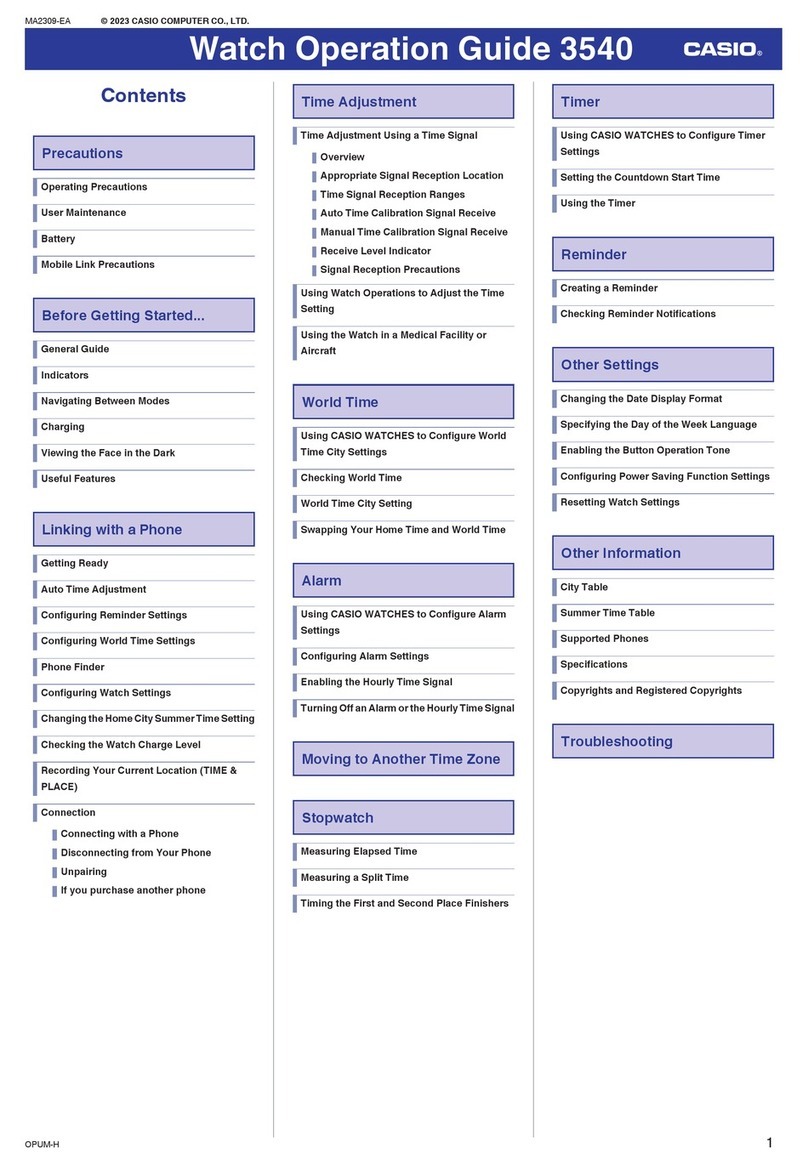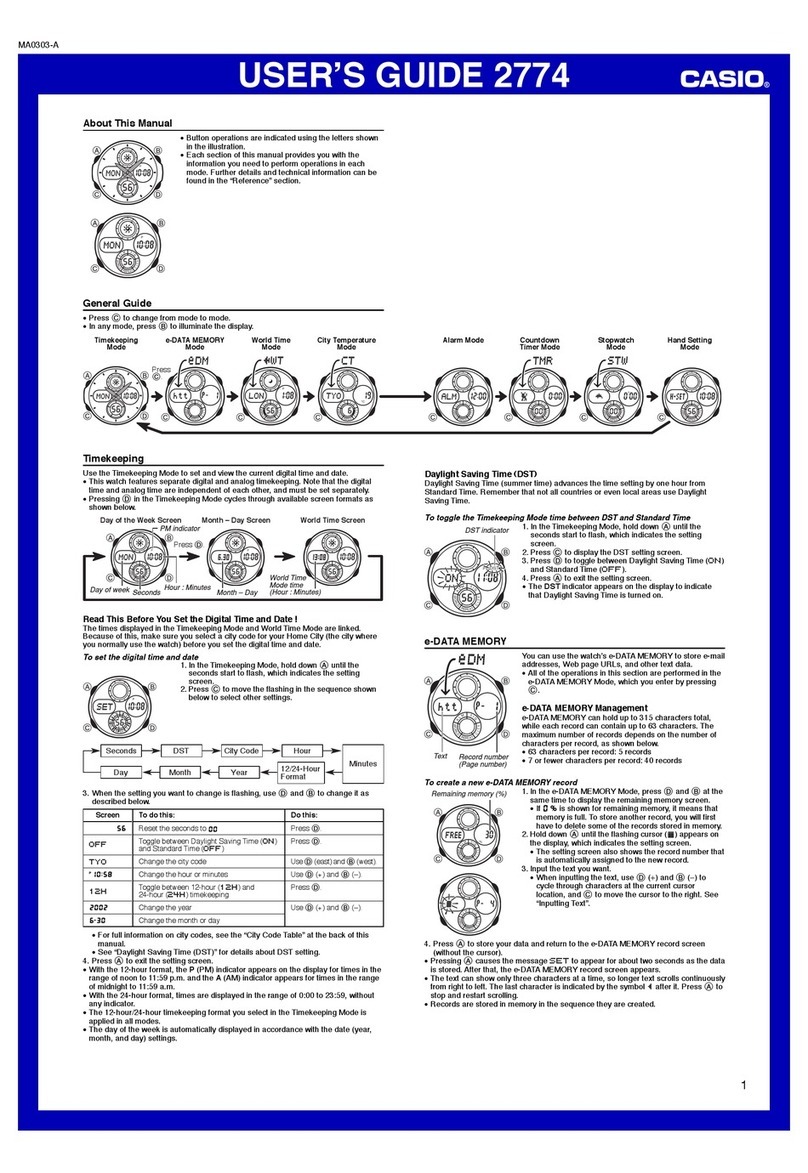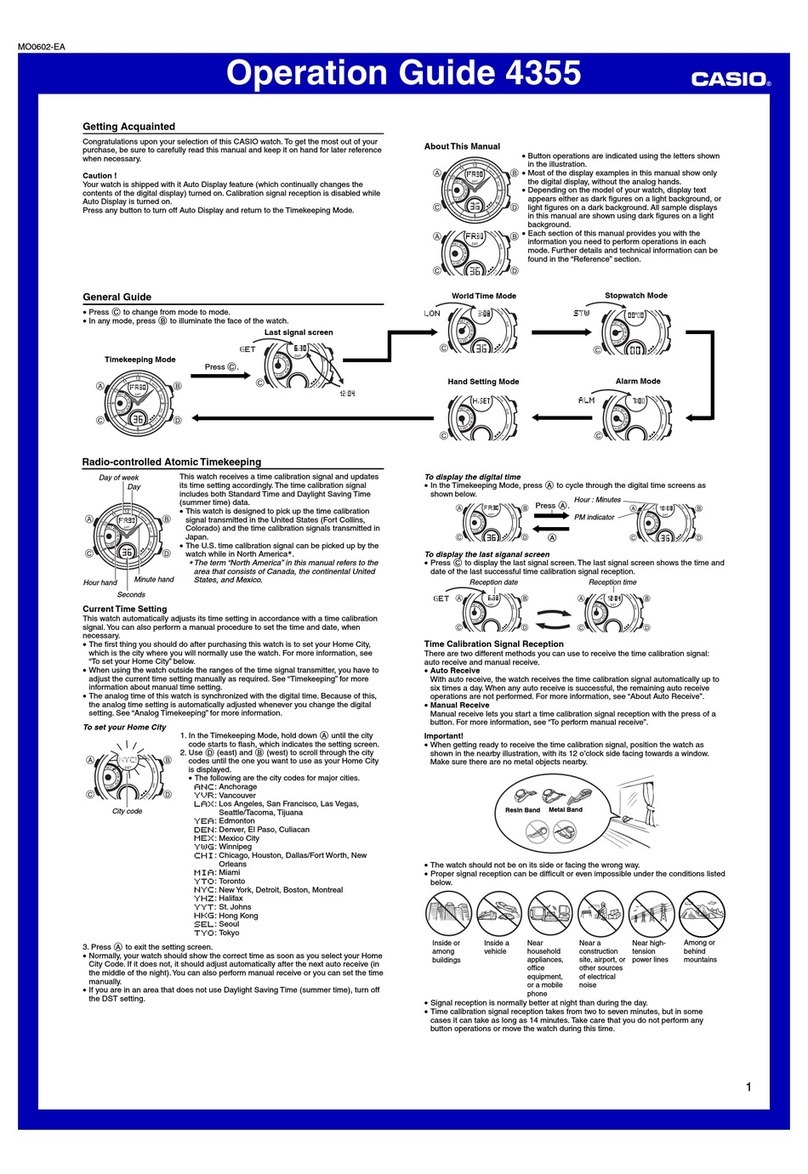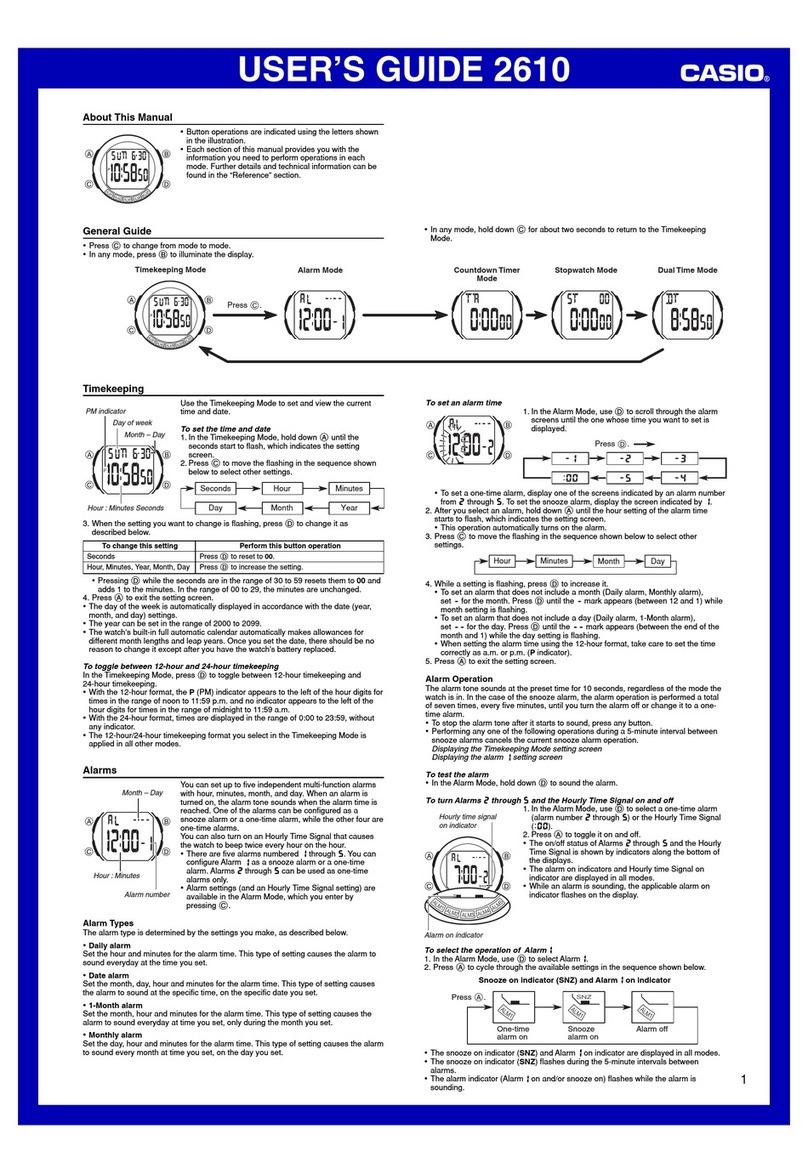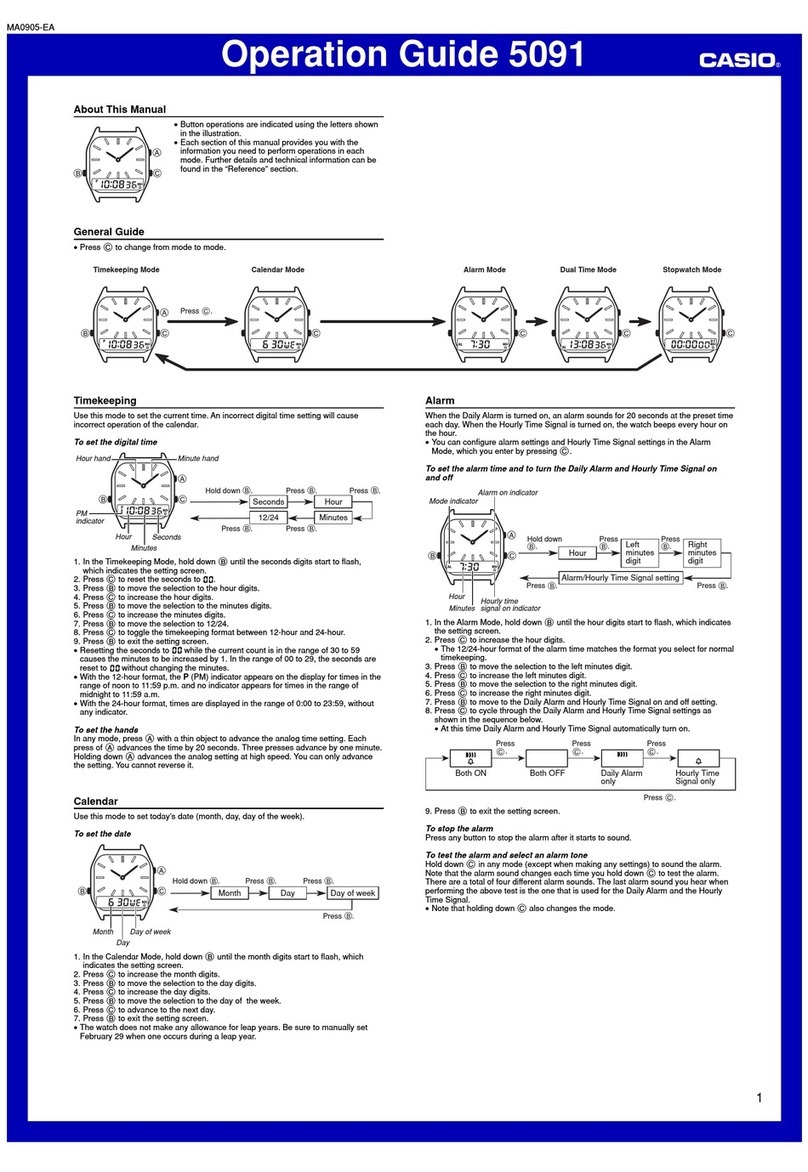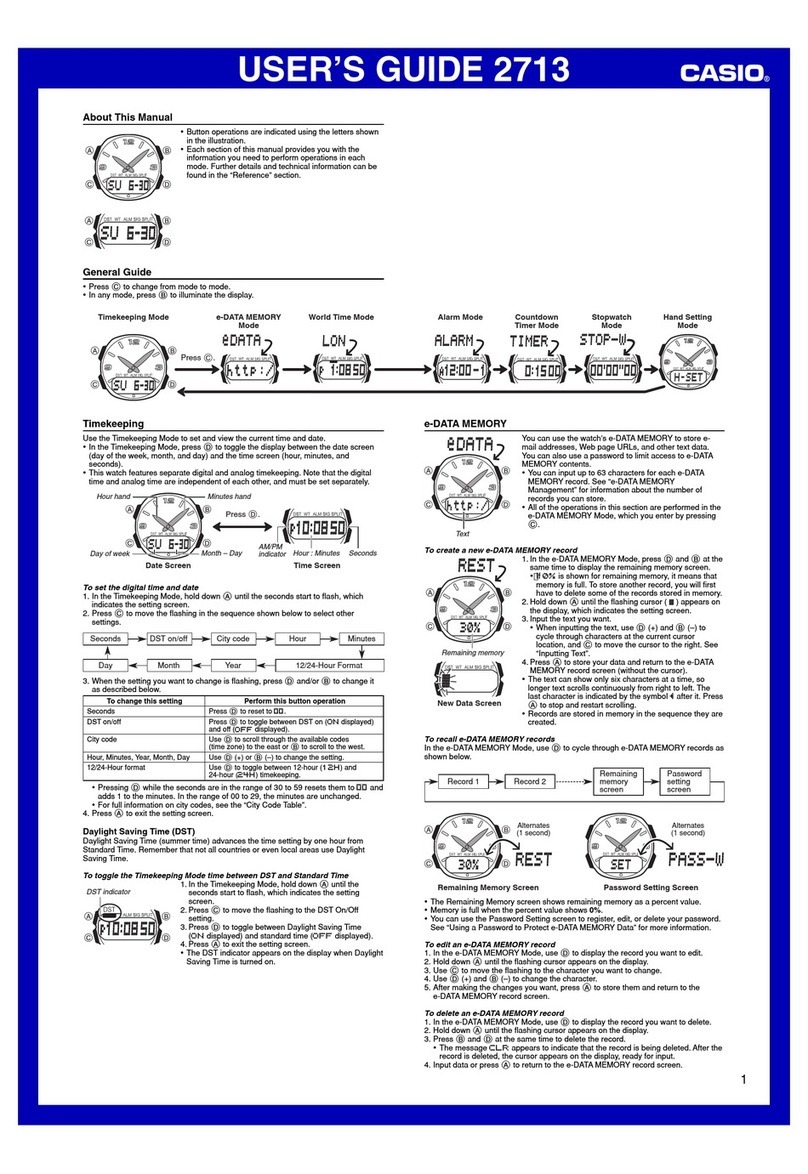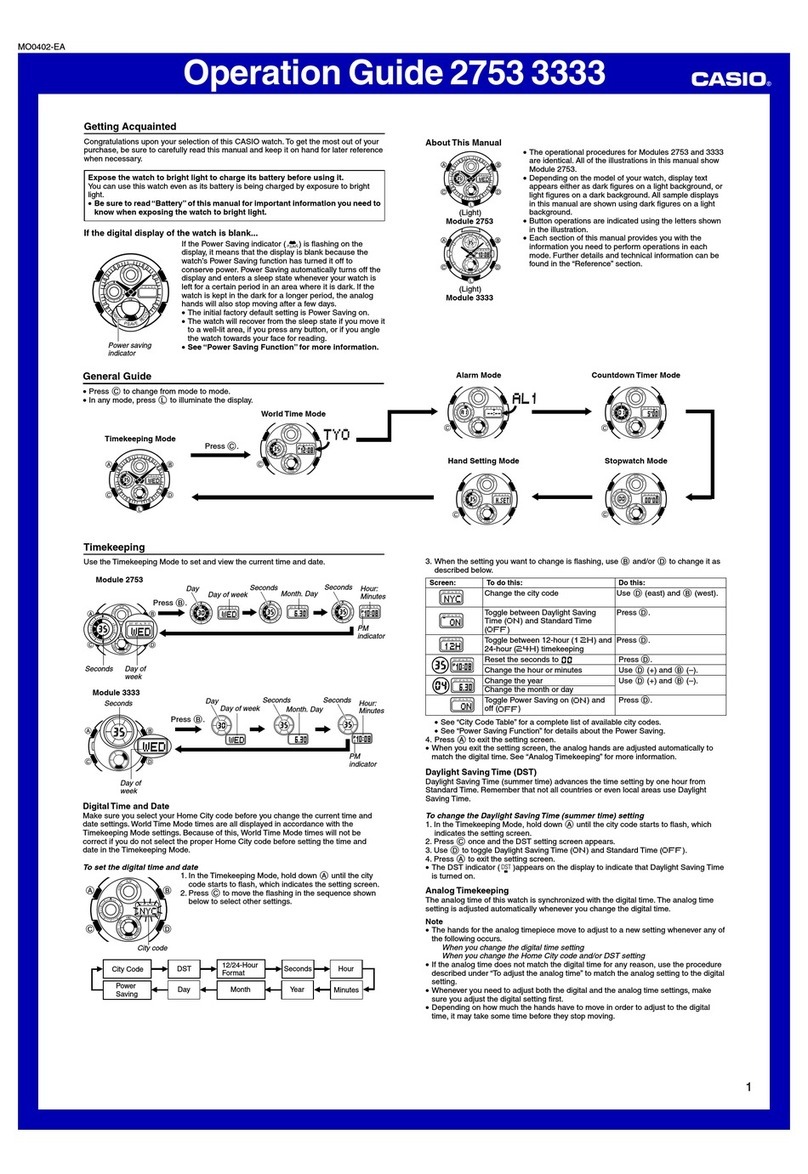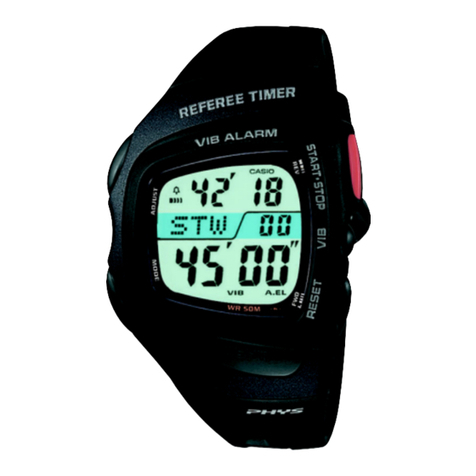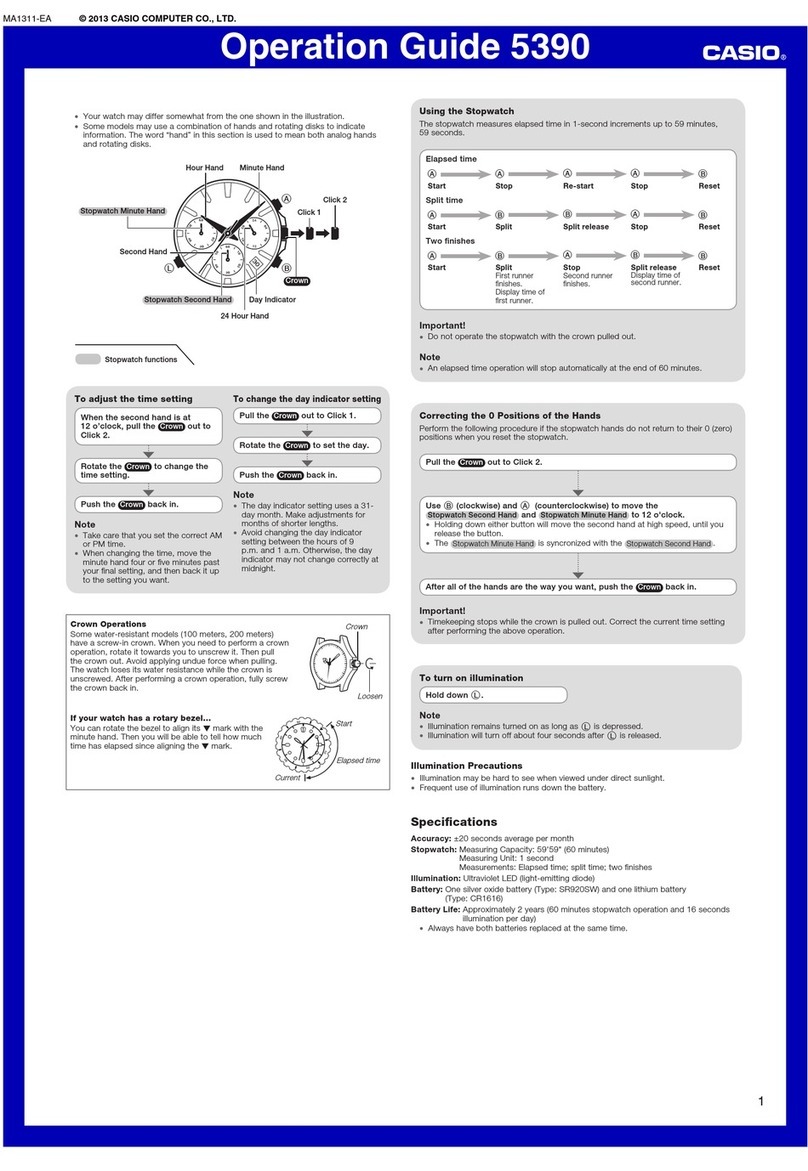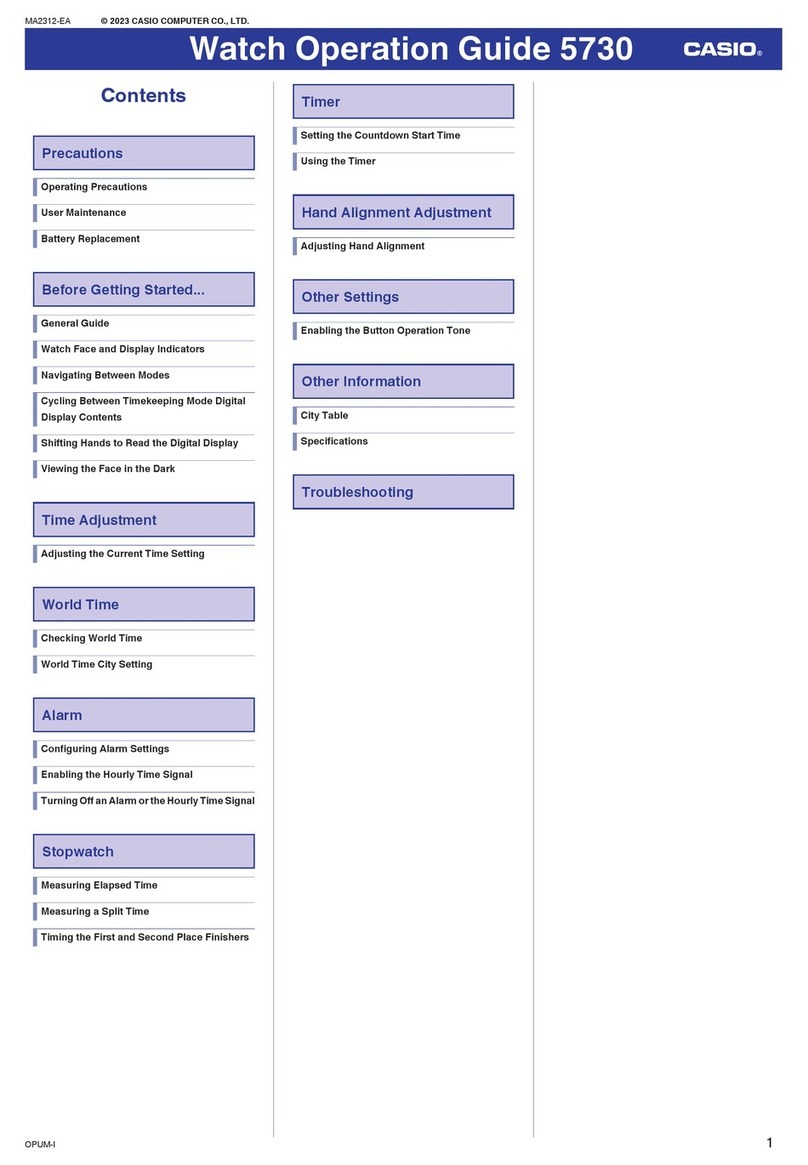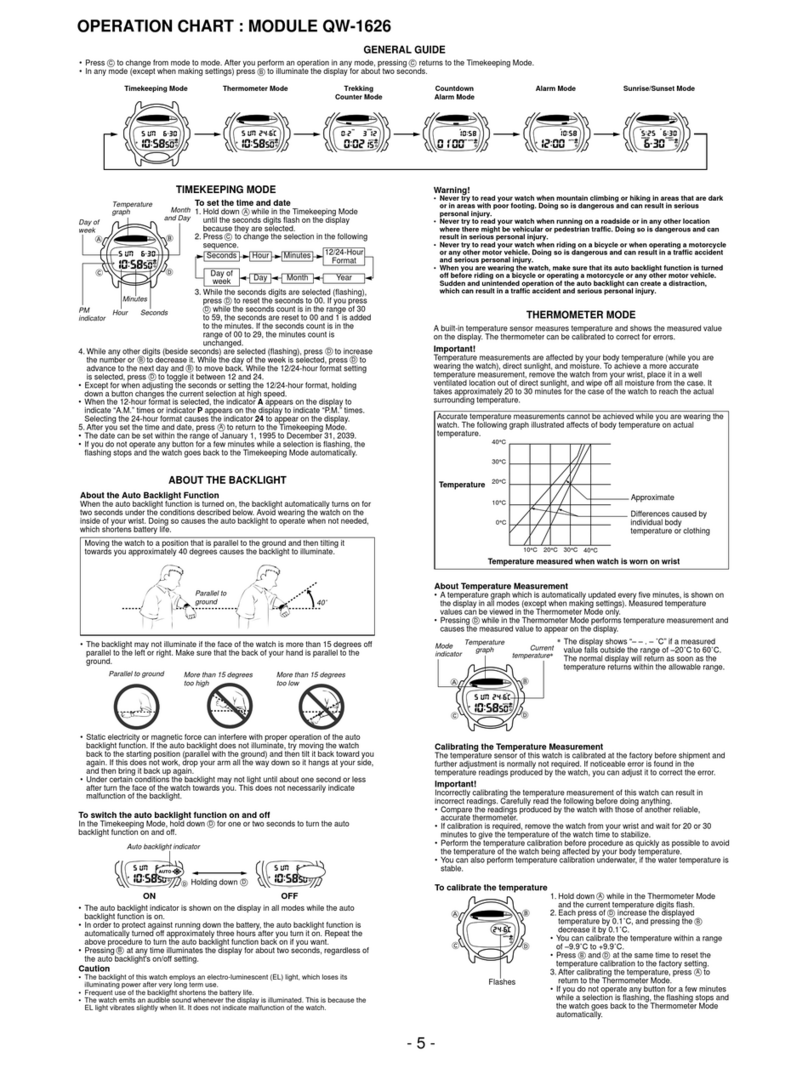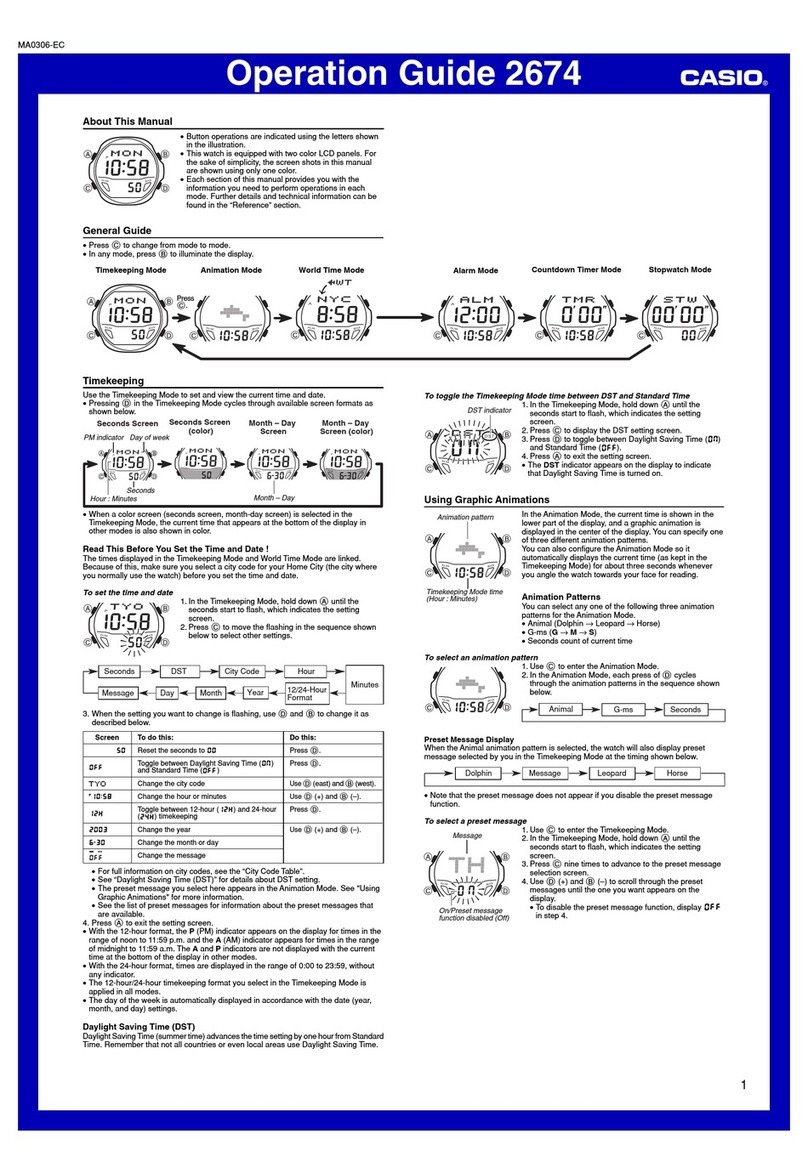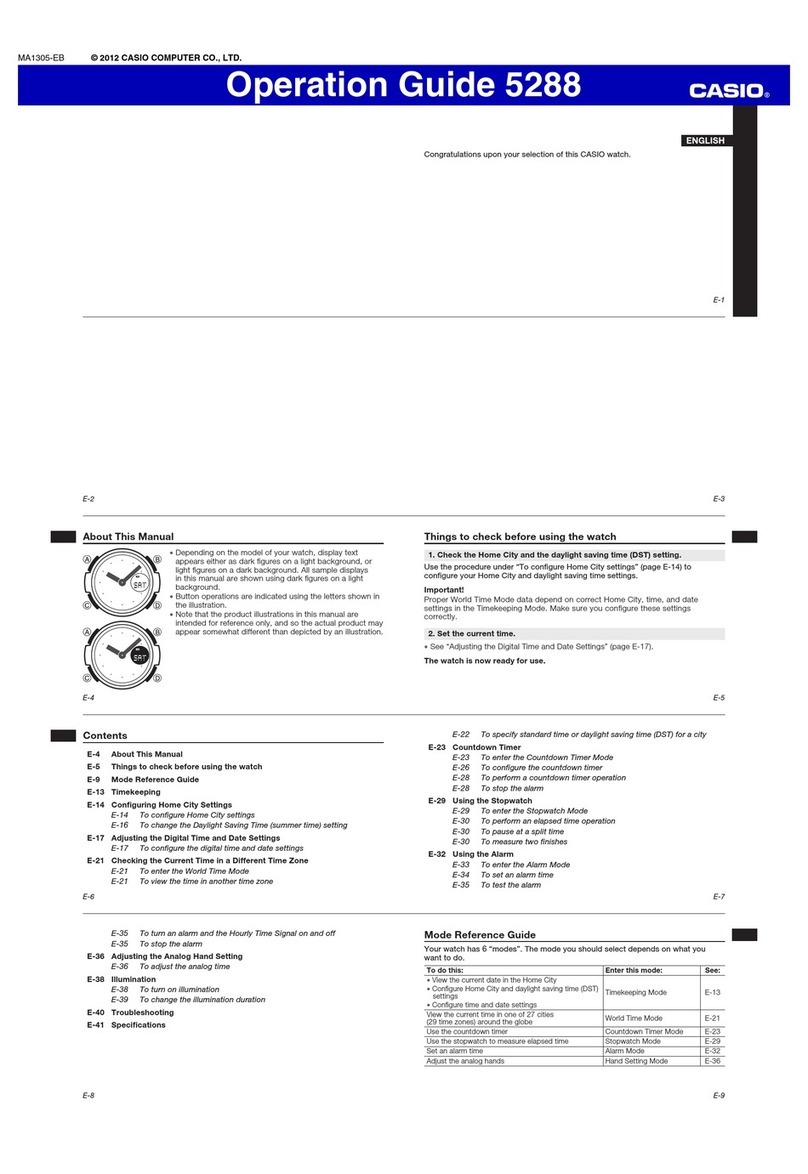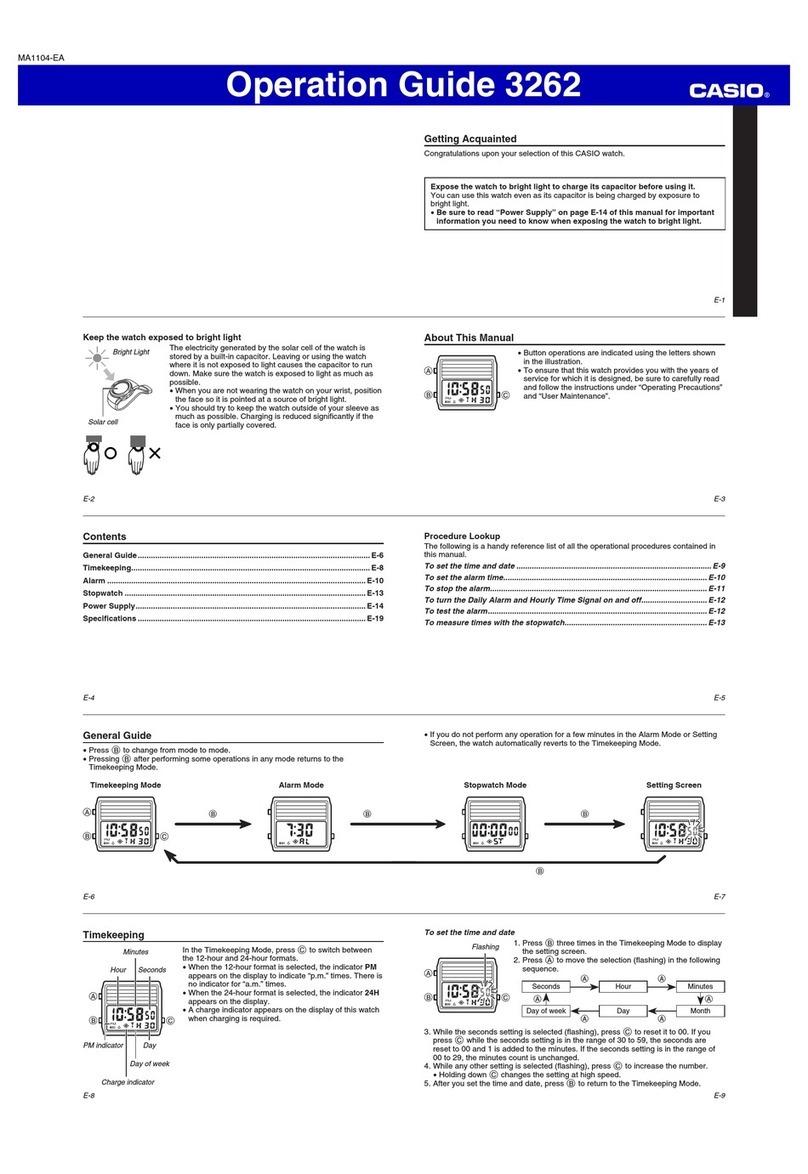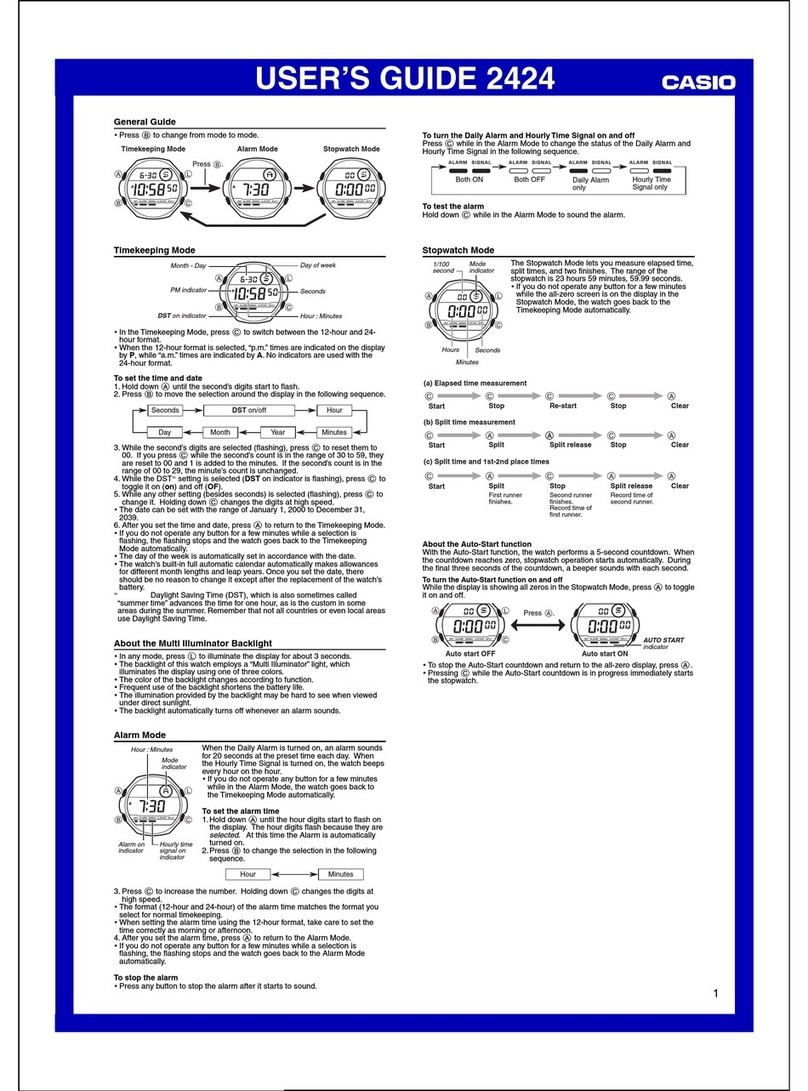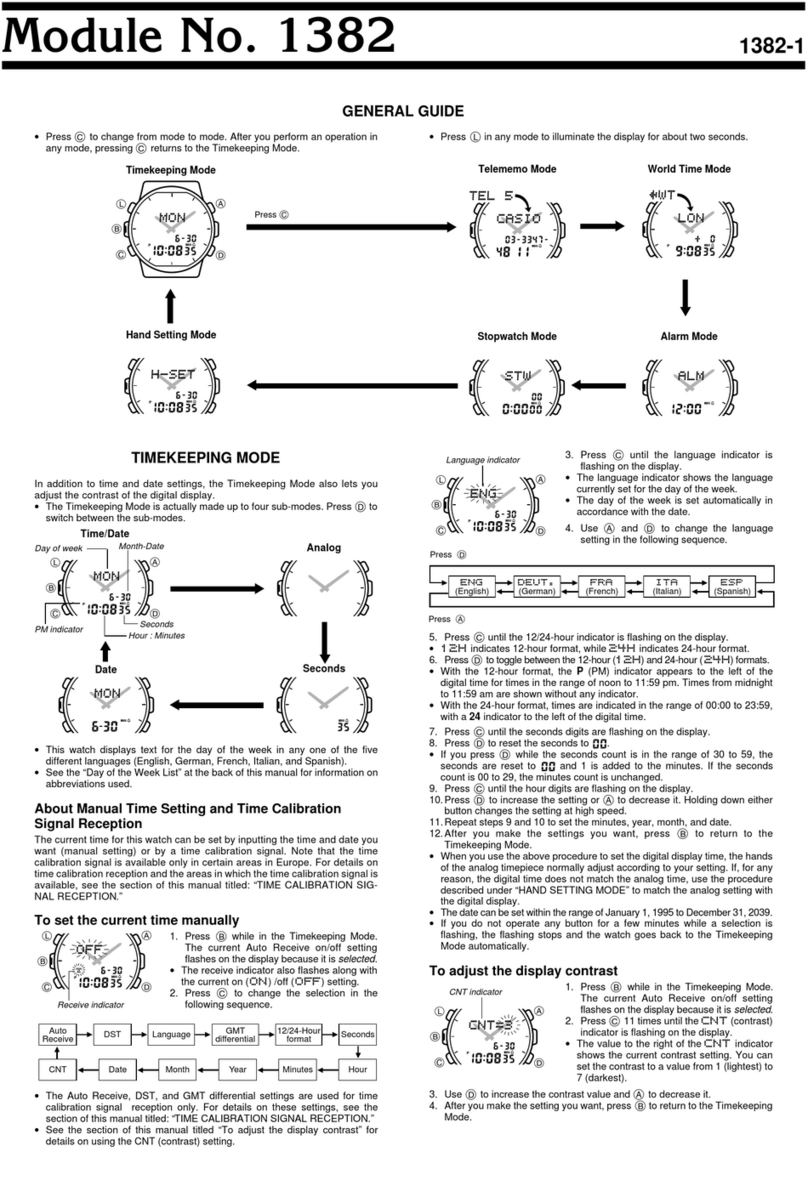
4
Operation Guide 5075 (OC)
Swapping your Home City and World Time City
You can use the procedure below to swap your Home City and World Time City. This capability can come in
handy when you frequently travel between two locations in different time zones.
The following example shows what happens when the Home City and World Time
City are swapped while the Home City originally is TOKYO (TYO) and the World
Time City is NEW YORK (NYC).
Home City World Time City
Before swapping
TOKYO
10:08 p.m.
(Standard time)
NEW YORK
9:08 a.m.
(Daylight saving time)
After swapping
NEW YORK
9:08 a.m.
(Daylight saving time)
TOKYO
10:08 p.m.
(Standard time)
To swap your Home City and World Time City
In the World Time Mode, use1. Dto select the World Time City you want.
In this example, you would move the•xSecond Hand to NEW YORK (NYC) in
order to select New York as the World Time City.
Wait until the•bLeft Dial Hands complete their move to the time in the
currently selected World Time City. You will not be able to perform step 2 of
this procedure until the hands stop moving.
Hold down2. Bfor about three seconds until the xSecond Hand starts to move.
This will make the World Time City (•NEW YORK/NYC in this example) your
new Home City. At the same time, it will change the Home City you had
selected prior to step 2 (TOKYO/TYO in this example), to your World Time
City.
After swapping the Home City and World Time City, the watch will stay in the World Time Mode. The•
xSecond Hand will point to your new World Time City (TOKYO/TYO in this example).
The•bLeft Dial Hands will indicate the current time in your new World Time City.
Note
If your current World Time City supports time calibration signal reception, making it your Home City enables•
calibration signal reception for that city.
Auto Correction of Hand Home Positions
Strong magnetism or impact can cause the hands and/or day setting to be off, even if the watch is able
to perform the signal receive operation. Auto correction of hand home positions correct the hand position
automatically.
Auto correction is performed in the Timekeeping Mode only.•
Auto correction corrects the positions of the•zHour Hand, cMinute Hand, and xSecond Hand. For the
dial hands and day, you must perform the manual adjustment procedure under “Adjusting Home Positions
Manually”.
Each hour, the watch performs automatic correction of the hand positions from –55 minutes to +5 minutes.•
You also can trigger auto correction of hand home positions manually, if you want. See “To trigger auto•
correction of hand home positions” for more information.
Auto correction of hand home positions can take up to three and a half minutes to complete.•
If hand positions are off by one hour or more, correct them using the procedure under “To trigger auto•
correction of hand home positions” or “Adjusting Home Positions Manually”.
To trigger auto correction of hand home positions
Perform the following procedure when the time setting is off.•
In the Timekeeping Mode, hold down Dfor about six seconds until the xSecond
Hand completes one full revolution.
Though the•xSecond Hand will stop momentarily about three seconds after
you hold down D, do not release the button yet. Wait until the xSecond Hand
completes a full revolution before you release D.
To interrupt an ongoing correction operation and return to the Timekeeping•
Mode, press Dagain.
If you release•Dwhen the xSecond Hand stops the first time (after about
three seconds) in the above operation, the watch will enter the home position
adjustment mode, which is described under “Adjusting Home Positions
Manually”. If this happens, press Ato return to the Timekeeping Mode and then
perform the above operation again.
Manually triggered auto correction of hand home positions performs the following•
two steps.
The hands will move automatically in order to determine the home positions of1.
the watch.
After the hand home positions are determined, the watch will return to normal2.
timekeeping automatically. This completes the correction operation.
Adjusting Home Positions Manually
Strong magnetism or impact can cause the hands and/or date of the watch to be off, even if the watch is able
to perform the signal receive operation. If this happens, perform the applicable home position adjustment
procedures in this section.
Hand home position adjustment is not required if the time and day settings are correct.•
You also can use auto correction of the hand home positions to correct the home positions of the•zHour
Hand, cMinute Hand, and xSecond Hand.
Note
Any time after you enter the home position adjustment mode in step 1 of the following procedure, you
can return to the Timekeeping Mode by pressing A. The watch also will return to the Timekeeping Mode
automatically if you do not perform any operation for about two or three minutes in the home position
adjustment mode. In either case, any adjustments you made before the watch returned to the Timekeeping
Mode will be applied.
To adjust home positions manually
Hold down1. Cfor about two seconds until the xSecond Hand stops and then
starts moving again.
Hold down2. Dfor about three seconds.
The•xSecond Hand will start to move when you first press D. Keep D
depressed until the xSecond Hand stops.
The watch is now in the home position adjustment mode.•
The watch will exit the adjustment mode automatically if you do not perform•
any operation for about two or three minutes.
First is•xSecond Hand home position adjustment.
If the•xSecond Hand moves to 12 o’clock, it is in the correct home position. If
it doesn’t, use Dto move it to 12 o’clock.
Each press of•Cin the home position adjustment mode will cycle through the
adjustment settings as shown below.
xSecond zHour/ cMinute/ v24-hour bLeft Dial Hands
nRight Dial HandmDay
When adjusting a hand or the date home position, it is recommended that after you move to a proper•
home position, you press Bto move the setting back one step. Next, press Dagain to return it to the
home position. This helps to ensure better home position adjustment accuracy.
After confirming that the3. xSecond Hand is at the proper home position, press C. This will switch to
zHour Hand and cMinute Hand home position adjustment.
The•zHour Hand and cMinute Hand are at their proper home positions if they both move to 12 o’clock.
The v24-hour Hand also will move along with zHour Hand movement, and cannot be adjusted
individually. If the hands are not positioned correctly, use D(+) and B(–) to move them to their proper
home positions.
After confirming that the4. zHour Hand and cMinute Hand are in their correct
home positions, press C. This will switch to bLeft Dial Hand home position
adjustment.
The•bLeft Dial Hands are at their proper home positions if they both move to
24. If the hands are not positioned correctly, use D(+) and B(–) to move
them to 24.
After confirming that the5. bLeft Dial Hands are in the correct home position,
press C. This will advance to nRight Dial Hand home position adjustment.
The•nRight Dial Hand is in the correct home position if it is pointing at 0. If it
isn’t, use D(+) and B(–) to move it to 0.
After confirming that the6. nRight Dial Hand is in the correct home position, press
C. This will advance to day home position adjustment.
The•mDay is in the correct home position if it shows 1. If it doesn’t, use D(+)
and B(–) to change the day to 1.
Press7. Ato return to the Timekeeping Mode.
The•mDay moves to the current day, and then the zHour Hand and the
cMinute Hand will move to the current time. Wait until everything stops
moving.
Troubleshooting
Hand Movement and Position
I lost track of what mode the watch is in.
Refer to “To select a mode”. To return directly to the Timekeeping Mode from any other mode, hold down C
for about two seconds.
The xSecond Hand is moving at two second intervals.
All the watch’s hands are stopped at 12 o’clock and none of the buttons work.
Power may be low. Expose the watch to light until the xSecond Hand starts moving normally, at one-second
intervals.
The hands of the watch suddenly start moving at high speed, even when I do not perform any
operation.
This could be due to any one of the following causes. In all cases, the hand movement does not indicate
malfunction, and should stop shortly.
The watch is recovering from a sleep state.•
The time setting is being adjusted following a successful auto time calibration signal receive operation.•
The current time setting is off by hours.
Your Home City setting may be wrong. Check your Home City setting and correct it, if necessary.
The current time setting is off by one hour.
If you are using the watch in an area where time calibration signal reception is possible, see “To configure
Home City settings”.
If you are using the watch in an area where time calibration signal reception is not possible, you may need to
change your Home City’s STD (standard time)/DST (daylight saving/summer time) setting manually. Use the
procedure under “To toggle the Home City time between standard time and daylight saving time” to change the
STD/DST setting.
The hands and/or day indications are off.
This could indicate that the watch has been exposed to magnetism or strong impact, which has caused
problems with proper hand and day alignment. Adjust the watch’s hand and day home position alignment.
World Time Mode
The World Time indicated by the bLeft Dial Hands in the World Time Mode is one hour off from the
actual time in the selected time zone.
The STD (standard time)/DST (daylight saving/summer time) setting of the selected World Time City may be
wrong. Select the correct STD (standard time)/DST (daylight saving/summer time) setting.
The World Time indicated by the bLeft Dial Hands in the World Time Mode is off.
Your Home City settings may be wrong. Check your Home City settings and correct them, if necessary.
Charging
The watch does not resume operation after I expose it to light.
This can happen after the power level drops to Level 3. Continue exposing the watch to light until the x
Second Hand starts moving normally (at one-second intervals).
The xSecond Hand starts to move at one-second intervals, but then suddenly returns to moving at
two-second intervals.
The watch probably is not sufficiently charged yet. Continue keeping it exposed to light.
Time Calibration Signal
The information in this section applies only when LONDON (LON), PARIS (PAR), ATHENS (ATH),
HONOLULU (HNL), ANCHORAGE (ANC), LOS ANGELES (LAX), DENVER (DEN), CHICAGO (CHI), NEW
YORK (NYC), HONG KONG (HKG), or TOKYO (TYO) is selected as the Home City. You need to adjust the
current time manually when any other city is selected as the Home City.
The xSecond Hand indicates NO (N) when I check the result of the latest receive operation.
Possible Cause Remedy
You are wearing or moving the watch, or performing•
a button operation during the signal receive
operation.
The watch is in an area with poor reception•
conditions.
Keep the watch in an area where reception conditions are
good while the signal receive operation is being performed.
You are in an area where signal reception is not
possible for some reason. See “Approximate Reception Ranges”.
The calibration signal is not being transmitted for
some reason.
Check the website of the organization that maintains the•
time calibration signal in your area for information about its
down times.
Try again later.•
The current time setting changes after I set it manually.
You may have the watch configured for Auto Receive of the time calibration signal, which will cause the time
to be adjusted automatically according to your currently selected Home City. If this results in the wrong time
setting, check your Home City setting and correct it, if necessary.







